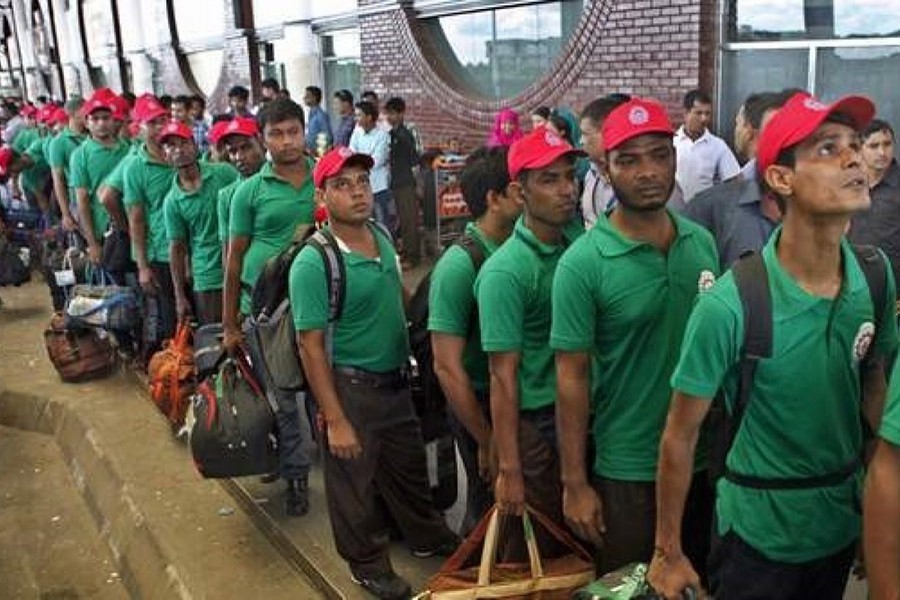The past year experienced a rough patch for overseas jobseekers with job markets either shrinking or getting largely shut in some countries. This was accompanied with problems like harassment of migrant workers in host countries, deceitful practices by local manpower agents, imprisonment of undocumented and visa-expired workers, deportation of a large number of them, and last but not least, criminal maltreatment of female workers in some Middle Eastern countries.
A FE report some days ago presented a picture of the state of things. Referring to the host countries' policies restricting foreign workers' employments that dampened the prospect for overseas jobs, the report mentioned that between January and November last year, the number of overseas employments declined to 604,060 from 684,962 compared to the same period of 2018. About 89 per cent workers migrated to the Arab and Gulf countries while 11 per cent to other countries. The outflow of workers was higher in 2017 when it was 1.0 million. Saudi Arabia, which is the largest destination for Bangladeshi workers, slapped a ban on recruiting foreign workers in 42 trades, which has significantly shrunk the scope for jobs there. Because of the ban, a large number of Bangladeshi workers who went there with so-called free visas faced difficulties in getting jobs. Many of them were deported. A total of 55,335 Bangladeshis were deported on various grounds, including expiry of visas, during the January-November period. Of them, 24,281 workers, including women, returned home from Saudi Arabia alone, almost double the total number of deportees.
A study titled 'Labour Migration Trend Report-2019' released recently by the Refugee and Migratory Movements Research Unit (RMMRU) said overseas jobs for Bangladeshi workers in 2019 is estimated to fall 10 per cent from that of the previous year. The amount of inward remittance, however, is expected to rise by about 17.05 per cent over the last year to reach US$ 18.19 billion. The study said inward remittance during the year increased mainly due to the cash incentives provided by the government to encourage migrant workers to send money through formal channels. The study mentioned that overseas jobs for Bangladeshi workers shrank mainly due to the closure of Malaysian labour market.
Government incentive for channeling money through official procedure is not the lone factor for the surge in remittance. Weakening of the taka, too, is a factor to keep in mind. Still, it seems as though we are content to see the money, as some media reports tend to make us convinced that things are not bad - so long money keeps flowing and increasing.
In reality, as the FE report mentioned above says, there is very little in sight on the manpower export front to inspire hope. The figures of inward remittance appear as regular news stories in the print media, obviously because of its very high stake in the economy since decades. The economic implications of remittance, besides catering to the dire needs of a large segment of the population, are many and diverse, and should in all fairness be looked at positively.
Many conscious citizens are quick to conclude that it is predominantly the government agencies' failure to take an objective and comprehensive view of workers' migration that has turned things from bad to worse, lately. As a result, botched up moves, mostly half-hearted and indecisive, have done more harm than good for the migrant workers. The migration of women workers may be seen as a case in point. One has reasons to doubt there was any well thought-out plan or homework on the part of the government before deciding to send thousands of unskilled rural women to go and work in the Middle Eastern countries. There were reportedly no worthwhile moves to ensure their personal and workplace safety, nor was there any binding agreement with the employers to address the many associated welfare issues. What eventually has been the lot of most of these women is not just undesirable but scary. Many have returned with chilly tales of atrocities.
It is needless to reiterate that negligence has made workers' migration a vortex of unspeakable evil and utter misfortune. The government has failed to rein in the abusive recruitment practices resulting in debt bondage, forced labour and human trafficking by unregulated intermediaries.
Now that overseas employments are shrinking, isn't it time to sit up, mend the previous wrongs and plan things afresh? What is needed most is a well thought-out migration policy. Clearly, sending unskilled workers no longer holds good prospect. And when it comes to catering for semi-skilled and skilled jobs, it is critically important to create demand-based skills and upgrade training in keeping with the market-specific needs.
The authorities should go for a comprehensive policy to create required skilled workforce to stay competitive in overseas job markets, envisaging also its framework streamlined recruitment, migration cost, job related welfare issues etc. Protecting the workers through such a policy would require active involvement of the government in ensuring an overseeing mechanism. More important perhaps is the government's role to see that the job contracts are not violated in the overseas stations, salary and welfare packages are duly honoured by the employers, work permit and appropriate visas are quickly facilitated by the respective authorities of the host governments.


